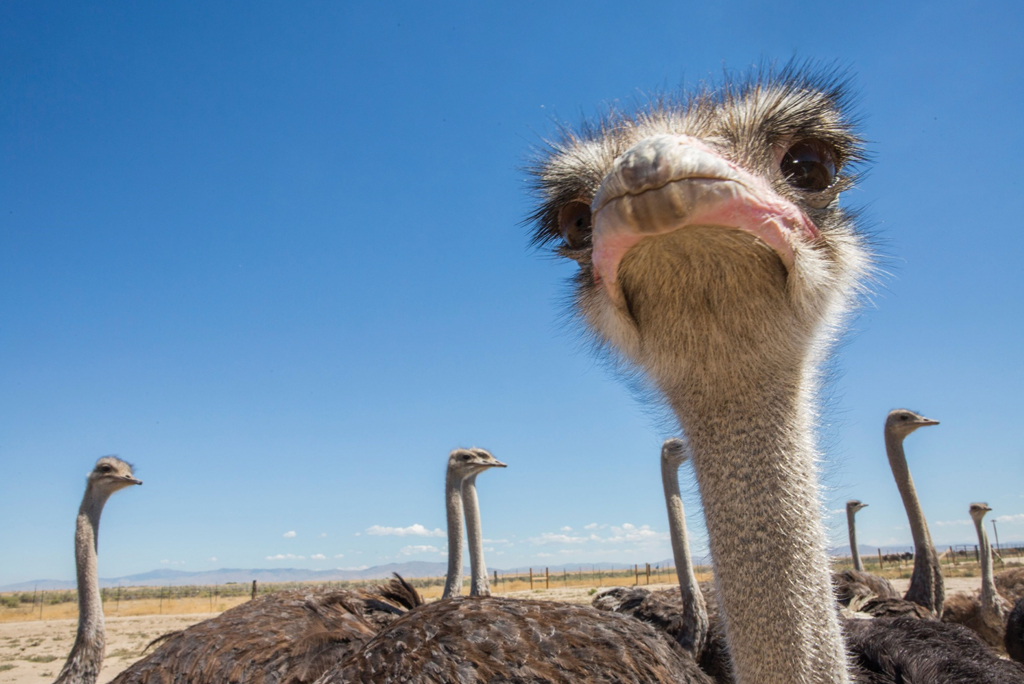Halfway around the world from the Wood River Valley, Alex McCoy discovered ostriches, and they changed his life.
Now he is on a quest to introduce the birds to others and transform their lives and the world. Alex grew up in Ketchum and currently lives in Sun Valley with his wife, Lauren, and three girls, aged 5, 6 and 8.
“In 2011, living in South Africa and training for an Ironman triathlon, I first tasted ostrich,” recalls McCoy. “Although I was on a strict training diet, I was craving red meat and ate a huge ostrich steak on a ‘cheat day’.”
McCoy knew beef might make him lethargic, but after his meal of ostrich meat, he felt energized and completed a 16-mile run that was among his fastest during months of training. “Because I realized ostrich was an option that could satisfy red meat cravings and allow us to eat healthfully, I was determined to bring it into the mainstream back home in the U.S.”
McCoy planned to use his experience as a venture capitalist and international financier to help other ostrich farmers but found few in America. Instead, in 2013, he founded American Ostrich Farms. The largest ostrich producer in North America, American Ostrich Farms stretches over 120 acres in Kuna, Idaho, and is home to more than 2,000 birds.
“I started this company to give Americans a better alternative to red meats. If consumers like beef, they’re going to love ostrich. Ostrich tastes like a delicious, lean filet mignon but is higher in iron and lower in cholesterol, saturated fat and calories. I’m surprised it’s not a protein staple, and we’re working hard to make it more available beyond directly through our website, so customers have convenient access to ostrich wherever they shop for groceries,” declares McCoy.
According to Iowa State University’s Agricultural Marketing and Resource Center’s website, “With a texture and color similar to beef, it is low in fat, calories and sodium. It has less cholesterol than beef, chicken or turkey.”
American Ostrich Farms employs state-of-the-art technology to enable the birds to be more environmentally sustainable and minimize their resource use, which includes intensive application of cloud-based monitoring and analysis via hundreds of sensors located throughout their incubation, hatch and young livestock rearing facilities, as well as their on-farm slaughter and processing plant.
Their new slaughter plant, funded partly by the Sun Valley Institute for Resilience’s Idaho Impact Fund, has enabled AOF to control the product quality, sustainability, and humane handling of their now vertically integrated operation to the degree that is exceedingly rare in animal protein production.
“We have spent years working on our flock genetics to continually improve the chick, and thus product, yield per breeder.”
McCoy is proud of the efforts and early results of the farm’s genetics research, which is discovering which bloodlines yield the most efficient and reliably healthy offspring from chick to juvenile to harvest.
Each ostrich egg weighs about three and a half pounds, equivalent to 24 chicken eggs. The eggs are collected and cleaned daily and incubated for 42 days. Each chick is over a foot tall when it hatches and ostriches grow rapidly. After 12 months, each chick has grown to more than 200 pounds and is usually over 7 feet tall.
“Our best birds are selected for future breeding stock and the remaining birds are processed,” states McCoy. “All of our meat is USDA inspected, vacuum sealed and frozen for maximum freshness.
“Our philosophy is if you’re going to raise livestock, care for it, and then take its life, you’d better be using that entire animal and not wasting anything. Virtually every part of the ostrich can be used to create products that consumers love.”
Meat is the farm’s main product, but they also have a line of pet treats, sell eggshells and try to monetize every part of the animal.
“Nothing goes to waste. Beyond delicious burgers and steaks, our hides become gorgeous leather products. Feathers are used for decoration, costumes, and many other commercial applications.”
AOF turns fat into a line of cosmetics, soaps, and all-natural moisturizing oils and lotions under the brand “AOF Skincare”.
Alex’s wife Lauren notes, “Every product we produce holds up our core values, including the highest standards of environmental and animal welfare and no hormones or antibiotics ever. Our All-American supply chain supports American farmers and local communities.”
McCoy’s goal is for the ostrich to one day be in every grocery store and most restaurants.
“It’s the healthiest red meat there is—both for our bodies and for the planet. Compared to conventionally raised beef, ostriches use one-third of the freshwater, a fraction of the land, and emit less than one-tenth of the greenhouse gases per pound of meat produced,” McCoy reports. “This product connects really well with people who care not just about their own health but about the planet that we’re going to leave to our kids and grandkids. It’s our mission to bring Americans the most healthy, sustainable, environmentally friendly red meat in the animal kingdom. Ostrich is the natural answer in a world with a rapidly growing population where people want to eat red meat, yet water scarcity and shifting consumer tastes toward healthier, more sustainable food products make traditional red meats less attractive. Better living through ostrich is what we say.”


